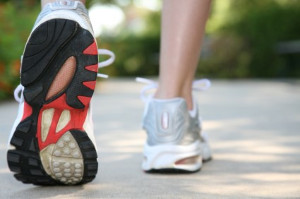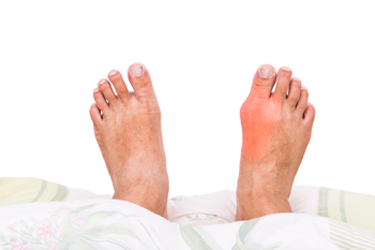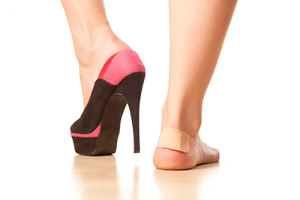Items filtered by date: November 2019
Different Shoes for Different Types of Running
 People who enjoy running are generally aware of the importance of choosing the right running shoe. These types of shoes fall into different categories based on running style. Additionally, for heavier runners, it is helpful to select shoes that have added stability. Research has indicated that determining how often running is practiced can help you to choose the correct shoe style. If your style of running includes exposure to mountains or trails, it may be beneficial to choose shoes that have additional traction. It is suggested that you consult with a podiatrist who can help you to determine which type of running shoe is best for you.
People who enjoy running are generally aware of the importance of choosing the right running shoe. These types of shoes fall into different categories based on running style. Additionally, for heavier runners, it is helpful to select shoes that have added stability. Research has indicated that determining how often running is practiced can help you to choose the correct shoe style. If your style of running includes exposure to mountains or trails, it may be beneficial to choose shoes that have additional traction. It is suggested that you consult with a podiatrist who can help you to determine which type of running shoe is best for you.
You should always make sure your running shoes fit properly in order to avoid injury. For more information, contact one of our podiatrists from Sayville Foot Care. Our doctors can provide the care you need to keep you pain-free and on your feet.
Choosing the Right Running Shoe for Your Foot Type
Improper shoe sizing can cause a myriad of problems for your feet. Shoes that don’t fit you properly can lead to muscular imbalances in your body, which can result in foot, knee, and hip injuries.
Tips for Finding the Right Running Shoe
- Make sure you have a thumb’s width of wiggle room between the end of your longest toe and the front of the shoe.
- There should be little to no slipping at the heel
- Don’t assume your size in one shoe brand will be your size in another
- Do not lace up your shoes too tightly
- Walk around in the store with your new shoes before you buy them
If you have any questions please feel free to contact our our office located in Sayville, NY . We offer the newest diagnostic and treatment technologies for all your foot and ankle needs.
Possible Treatments for Hammertoe
The condition that is referred to as hammertoe can occur when the tendons in the toes are out of balance. The big toe may gradually move toward the other toes, which may lead to pressure and pain. This can happen as a result of wearing shoes that do not have adequate room for the toes to move freely in, or genetic factors may also play a significant role in the development of hammertoes. Some patients find moderate relief when custom-made insoles are worn, which may help to stop the toes from rubbing together. In severe cases, having surgery performed may be an option that can permanently straighten the toes. If you are afflicted with hammertoe, it is strongly advised that you consult with a podiatrist as quickly as possible so the correct type of treatment can begin.
Hammertoe
Hammertoes can be a painful condition to live with. For more information, contact one of our podiatrists from Sayville Foot Care. Our doctors will answer any of your foot- and ankle-related questions.
Hammertoe is a foot deformity that affects the joints of the second, third, fourth, or fifth toes of your feet. It is a painful foot condition in which these toes curl and arch up, which can often lead to pain when wearing footwear.
Symptoms
- Pain in the affected toes
- Development of corns or calluses due to friction
- Inflammation
- Redness
- Contracture of the toes
Causes
Genetics – People who are genetically predisposed to hammertoe are often more susceptible
Arthritis – Because arthritis affects the joints in your toes, further deformities stemming from arthritis can occur
Trauma – Direct trauma to the toes could potentially lead to hammertoe
Ill-fitting shoes – Undue pressure on the front of the toes from ill-fitting shoes can potentially lead to the development of hammertoe
Treatment
Orthotics – Custom made inserts can be used to help relieve pressure placed on the toes and therefore relieve some of the pain associated with it
Medications – Oral medications such as anti-inflammatories or NSAIDs could be used to treat the pain and inflammation hammertoes causes. Injections of corticosteroids are also sometimes used
Surgery – In more severe cases where the hammertoes have become more rigid, foot surgery is a potential option
If you have any questions please contact our office located in Sayville, NY . We offer the newest diagnostic and treatment technologies for all your foot and ankle needs.
Why Live with Pain and Numbness in Your Feet?
How Do Bunions Develop?
 The medical condition that is known as a bunion will typically develop gradually, and it is considered to be a bone deformity. The foot structure can change, and may occur as a result of wearing shoes that do not have ample room for the toes to move freely in. The lack of room may push the big toe toward the second toe, which may cause the joint in the bottom of the big toe to protrude. Additionally, genetic factors and medical conditions that can include arthritis may play a significant role in developing a bunion. Common symptoms that are associated with this condition can consist of pain or numbness, corns and calluses that may develop on the affected area, and the toe may have limited range of motion. If you notice a bunion that is beginning to develop, it is strongly suggested that you schedule a consultation with a podiatrist who can offer treatment techniques.
The medical condition that is known as a bunion will typically develop gradually, and it is considered to be a bone deformity. The foot structure can change, and may occur as a result of wearing shoes that do not have ample room for the toes to move freely in. The lack of room may push the big toe toward the second toe, which may cause the joint in the bottom of the big toe to protrude. Additionally, genetic factors and medical conditions that can include arthritis may play a significant role in developing a bunion. Common symptoms that are associated with this condition can consist of pain or numbness, corns and calluses that may develop on the affected area, and the toe may have limited range of motion. If you notice a bunion that is beginning to develop, it is strongly suggested that you schedule a consultation with a podiatrist who can offer treatment techniques.
If you are suffering from bunion pain, contact one of our podiatrists of Sayville Foot Care. Our doctors can provide the care you need to keep you pain-free and on your feet.
What Is a Bunion?
Bunions are painful bony bumps that usually develop on the inside of the foot at the joint of the big toe. As the deformity increases over time, it may become painful to walk and wear shoes. Women are more likely to exacerbate existing bunions since they often wear tight, narrow shoes that shift their toes together. Bunion pain can be relieved by wearing wider shoes with enough room for the toes.
Causes
- Genetics – some people inherit feet that are more prone to bunion development
- Inflammatory Conditions - rheumatoid arthritis and polio may cause bunion development
Symptoms
- Redness and inflammation
- Pain and tenderness
- Callus or corns on the bump
- Restricted motion in the big toe
In order to diagnose your bunion, your podiatrist may ask about your medical history, symptoms, and general health. Your doctor might also order an x-ray to take a closer look at your feet. Nonsurgical treatment options include orthotics, padding, icing, changes in footwear, and medication. If nonsurgical treatments don’t alleviate your bunion pain, surgery may be necessary.
If you have any questions, please feel free to contact our office located in Sayville, NY . We offer the newest diagnostic and treatment technologies for all your foot care needs.
The Benefits of Strengthening the Ankles
 Research has indicated that the biomechanics of the ankle may be compromised if high heels are frequently worn. They may affect balance and strength, and this can allow falls to occur. If the desire to wear high heels is strong, it may be beneficial to alternate wearing these types of shoes with shoes that have a lower and wider heel. It may help to perform specific stretches while sitting, and this may aid in restoring strength in the ankle. Additionally, the ankle joints may become more stable, which can help to reduce the risk of injury. Heel lifts are an effective stretch for the entire foot. This is done by standing and slowly lifting the heels up and down, and then alternating feet. If you would like additional information about how to strengthen your feet from frequently wearing high heels, please consult with a podiatrist.
Research has indicated that the biomechanics of the ankle may be compromised if high heels are frequently worn. They may affect balance and strength, and this can allow falls to occur. If the desire to wear high heels is strong, it may be beneficial to alternate wearing these types of shoes with shoes that have a lower and wider heel. It may help to perform specific stretches while sitting, and this may aid in restoring strength in the ankle. Additionally, the ankle joints may become more stable, which can help to reduce the risk of injury. Heel lifts are an effective stretch for the entire foot. This is done by standing and slowly lifting the heels up and down, and then alternating feet. If you would like additional information about how to strengthen your feet from frequently wearing high heels, please consult with a podiatrist.
High heels have a history of causing foot and ankle problems. If you have any concerns about your feet or ankles, contact one of our podiatrists from Sayville Foot Care. Our doctors can provide the care you need to keep you pain-free and on your feet.
Effects of High Heels on the Feet
High heels are popular shoes among women because of their many styles and societal appeal. Despite this, high heels can still cause many health problems if worn too frequently.
Which Parts of My Body Will Be Affected by High Heels?
- Ankle Joints
- Achilles Tendon – May shorten and stiffen with prolonged wear
- Balls of the Feet
- Knees – Heels cause the knees to bend constantly, creating stress on them
- Back – They decrease the spine’s ability to absorb shock, which may lead to back pain. The vertebrae of the lower back may compress.
What Kinds of Foot Problems Can Develop from Wearing High Heels?
- Corns
- Calluses
- Hammertoe
- Bunions
- Morton’s Neuroma
- Plantar Fasciitis
How Can I Still Wear High Heels and Maintain Foot Health?
If you want to wear high heeled shoes, make sure that you are not wearing them every day, as this will help prevent long term physical problems. Try wearing thicker heels as opposed to stilettos to distribute weight more evenly across the feet. Always make sure you are wearing the proper shoes for the right occasion, such as sneakers for exercising. If you walk to work, try carrying your heels with you and changing into them once you arrive at work. Adding inserts to your heels can help cushion your feet and absorb shock. Full foot inserts or metatarsal pads are available.
If you have any questions please feel free to contact our office located in Sayville, NY. We offer the newest diagnostic and treatment technologies for all your foot and ankle needs.
Read more about Why High Heels Are Not Ideal for Healthy Feet

